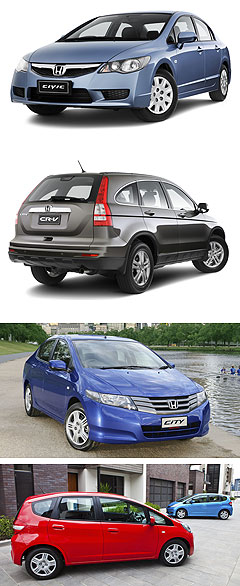Make / Model Search
News - HondaHonda car supplies sink in Thai floodsHard times: Honda's Thai plants - which build vehicles such as the Accord for the Australian market - have been hit hard by the recent floods. Floodwaters three metres deep in Honda factory spell tough times for Oz importer18 Nov 2011 HONDA Australia and its dealer network are facing lean times as shipments of most of its best-selling models dry up as a result of the Thailand floods and no word yet on a resumption of production at Honda’s swamped Rojuna factory – the worst hit of all Thai automotive assembly plants. Water has been flowing up to three metres deep through the plant at Ayutthaya for six weeks, not just halting production but wiping out stock in holding yards and doing untold damage to equipment. The factory, which supplies about three quarters of Honda Australia’s vehicles, including the Civic sedan, CR-V compact SUV, Accord, City and Jazz, has been off limits for weeks for safety reasons, meaning a full assessment of damage has been impossible. Honda Automobile Thailand says it still does not have a clear outlook for when it will resume car production, although limited production of motorcycles and power products is set to start at Ladkrabang, in a different area of Thailand. The floods have not only closed the Honda Rojuna car factory but those of many parts suppliers in the same region. Aerial TV shots of the Honda factory have shown cars completely underwater next to the main assembly plant, with water well up the factory walls.  Left: Thai-built Honda Civic, CR-V, City and Jazz. Left: Thai-built Honda Civic, CR-V, City and Jazz.If floodwaters have entered the factory at that depth, precision machinery and sensitive electrical equipment including assembly robots worth millions of dollars are bound to have been ruined. If so, the factory, which produces 4.5 per cent of global Honda vehicle supplies, could be closed for months for costly repairs. Honda Australia spokesperson and principal advisor Lindsay Smalley told GoAuto that the company had sufficient stock on hand to satisfy existing retail orders. “Stock will get tight in the next quarter,” he said. “However, we are closely monitoring the situation and prioritising retail orders across the network.” The Thai flood disaster follows hard on the heels of the Japanese earthquake that crippled Honda car production, in both Japan and Thailand. So far this year, Honda Australia car sales are down 25.2 per cent on the same period of 2010, but the sales drop is accelerating, with October’s volume down almost 40 per cent on the same month last year. Honda sold just 29 City light sedans last month, compared with 348 the year before – a drop of 91.7 per cent. Sales of the Thai-made Accord were down 86.5 per cent, CR-V down 30.9 per cent and Jazz down 5.0 per cent. Honda’s one-time best seller, the Civic, suffered a 51 per cent sales decline for the month, but that includes some UK-made hatchbacks that are unaffected by the floods. GoAuto has been told that Honda Australia has promised dealers a switch of some models such as Civic, Jazz and CR-V to Japanese production from December, but those cars will not begin arriving until January. Such a switch cannot be done easily, as all cars destined for the Australian market must be built to Australian Design Rules and advertised Australian specification – a nightmare to achieve without extensive planning, especially in an industry still recovering from the March earthquake and tsunami. Honda Australia is preparing to launch the Japanese-made CR-Z hybrid sports hatchback next week, and it says that event will go ahead without hiccup. However, the Thai floods have caused ripples throughout the Honda manufacturing network, with the company slowing production at its United States and Canadian plants until the end of November due to shortages of parts made in Thailand. Other Thai-based car-makers are starting to resume production, with Nissan announcing a return to limited production earlier this week. The Nissan plant, at Samut Prakan, was not directly affected by the floods, halted only by parts shortages. Toyota has announced that its Thai operations should resume on November 21, and will probably achieve full production within a week. Nissan and Toyota rely mostly on the Thai factories for their best-selling one-tonne utes, the Navara and HiLux. Compared with Honda, they and other Thai-based manufacturers such as Mitsubishi, Ford, Mazda and Isuzu got off lightly.  Read more |
Click to shareHonda articlesResearch Honda Motor industry news |










Facebook Twitter Instagram